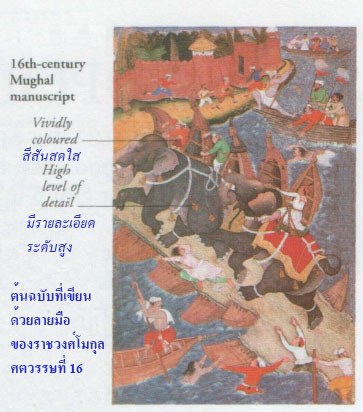Art in Africa
African art has a
long tradition, although a lack of written records make
its history hard to trace. Sculpture
and masks are major art forms. Most
art seems to have been made for religious or ritual purposes. Wood-carving
and bronze-casting techniques were highly developed.
|
ศิลปะในทวีปแอฟริกา
ศิลปะแอฟริกันมีประเพณีมายาวนาน แม้ว่าจะไม่มีประวัติที่เป็นลายลักษณ์อักษรทำให้ประวัติศาสตร์ติดตามได้ยาก
รูปปั้นและหน้ากากเป็นรูปแบบศิลปะที่สำคัญ ศิลปะส่วนใหญ่ดูเหมือนจะได้รับการสร้างขึ้นเพื่อจุดประสงค์ทางศาสนาหรือพิธีกรรม
เทคนิคการแกะสลักไม้และโลหะผสมทองสัมฤทธิ์ได้รับการพัฒนาขึ้นอย่างมาก
|
||||
| |
|||||
Sculpture
The rich tradition of sculpture in West
Africa begins with the pottery figures made by the Nok
people from 500 BC. Around
the 13th century AD the
Ife of Nigeria began to cast outstanding bronze heads and figures in a highly realistic style. These may have influenced sculptures
made in Benin, Nigeria, from the 16th
to 19th centuries.
|
ประติมากรรม
ประเพณีอันสวยงามของประติมากรรมในแอฟริกาตะวันตกเริ่มต้นด้วยรูปปั้นดินเผาซึ่งชาวนก
(Nok) สร้างขึ้น ตั้งแต่ 500 ปีก่อนคริสตกาล ประมาณคริสต์ศตวรรษที่ 13 เมือง Ife ของไนจีเรียเริ่มหลอมศีรษะและรูปหล่อทองสัมฤทธิ์อันโดดเด่นในรูปแบบที่สมจริงอย่างยิ่ง
สิ่งเหล่านี้อาจมีอิทธิพลต่อประติมากรรมที่ทำในเบนินไนจีเรียตั้งแต่ศตวรรษที่ 16
ถึง 19
|
Masks
African masks may
represent a spirit or ancestor, or be purely decorative. Their meaning comes
from the masquerade (dance, drama, and music) of which they are a part.
Wood, beads, ivory, and shells are important
materials. This capped mask, carved
in a bold, vital style, is from Cameroon.
|
หน้ากาก
หน้ากากแอฟริกันอาจเป็นตัวแทนของวิญญาณหรือบรรพบุรุษหรือเป็นเครื่องประดับตกแต่งเท่านั้น
ความหมายของหน้ากากเหล่านั้นมาจากการเต้นรำสวมหน้ากาก (เต้นรำ ละครและดนตรี)
ซึ่งมีหน้ากากเป็นส่วนหนึ่ง ไม้ ลูกปัด งาช้างและเปลือกหอยเป็นวัสดุที่สำคัญ
หน้ากากสำหรับปิดหน้านี้แกะสลักในรูปแบบที่เหมือนมีชีวิตชีวาฮึกเหิมมาจากแคเมอรูน
|
||
Asia
Traditionally
in Asian art, the symbolic meaning behind the subject of
a painting, sculpture, or carving is more important than the illusion of realism. In China,
for instance, landscape paintings are stylized to express the ideals of religious thought: natural
harmony, peace, and grace. In China
and Japan, calligraphy was seen as a high form of art. The inscriptions are usually of short,
poetic situations.
|
เอเชีย
ตามธรรมเนียมในศิลปะเอเชีย
ความหมายที่เป็นสัญลักษณ์ที่อยู่ด้านหลังของภาพเขียน ประติมากรรมหรือการแกะสลักมีความสำคัญมากกว่าภาพลวงตาของศิลปะสัจนิยม
ยกตัวอย่างเช่น ในประเทศจีนภาพวาดทิวทัศน์ได้รับการออกแบบให้ทันสมัยเพื่อแสดงถึงอุดมคติของความคิดทางศาสนา:
ความสามัคคีตามธรรมชาติ สันติภาพและคุณงามความดี ในประเทศจีนและญี่ปุ่น การประดิษฐ์ตัวอักษรเป็นรูปแบบศิลปะชั้นสูง
คำจารึกมักมีสถานการณ์ที่เป็นบทกวีสั้น ๆ
|
|
Miniatures
During the Mughal
Empire (16th-17th centuries), figurative miniature
painting flourished in India. These
were richly coloured and exceptionally delicate. This illustration comes from a
contemporary chronicle of the emperor's exploits.
|
ภาพวาดขนาดเล็กมาก
ระหว่างจักรวรรดิโมกุล (คริสต์ศตวรรษที่ 16-17) ภาพวาดรูปแกะสลักขนาดเล็กมีความเจริญรุ่งเรืองในอินเดีย ภาพเหล่านี้มีสีสันสมบูรณ์และสวยงามละเอียดอ่อน
ภาพประกอบนี้มาจากพงศาวดารร่วมสมัยกล่าวถึงความกล้าหาญของจักรพรรดิ
|
|
Native
American art
Sophisticated
Native American societies, such as the Aztec and Maya in
Mexico and the Inca in Peru, created distinct artistic and architectural styles. Nearly 3,000 years ago, nomadic peoples in North
and South America marked awe-inspiring "sculptures" on to the land, or created vast
earthworks whose shapes can only be seen from high in
the air.
|
ศิลปะพื้นเมืองอเมริกา
สังคมชนพื้นเมืองอเมริกันที่มีความซับซ้อนเช่น
แอซเท็กและมายาในเม็กซิโกและอินคาในเปรูสร้างรูปแบบศิลปะและสถาปัตยกรรมที่แตกต่างกัน
เกือบ 3,000 ปีที่ผ่านมา ชนเร่ร่อนในอเมริกาเหนือและอเมริกาใต้ทำเครื่องหมาย
"ประติมากรรม" อันน่าเกรงขามไว้บนบกหรือสร้างกำแพงดินขนาดใหญ่ที่มีรูปร่างสามารถมองเห็นได้จากที่สูงในอากาศเท่านั้น
|
|||
Totem poles (Left picture)
Complex in design,
and carved with great skill, totem poles showed
the status of many Native North American chiefs.
เสาโทเทม
(ภาพซ้ายมือ)
เสาโทเทมได้รับการออกแบบที่สลับซับซ้อนและสลักด้วยทักษะอันยิ่งใหญ่
แสดงถึงสถานะของหัวหน้าเผ่าในท้องถิ่นอเมริกาเหนือจำนวนมาก
|
|
|||
Sand
paintings (Right upper picture)
In
the Southwest, Native North Americans trickled coloured sand and ground stones on to a smooth
background to create temporary symbolic paintings with a ritual importance.
จิตรกรรมทราย
(ภาพขวาบน)
ในแถบตะวันตกเฉียงใต้ ชาวพื้นเมืองอเมริกัน หยดทรายสีและหินบดบนพื้นดินราบเรียบเพื่อสร้างภาพจิตรกรรมที่เป็นสัญลักษณ์ชั่วคราวที่มีความสำคัญทางพิธีกรรม
|
||||
Pacific art
Contact with
European Christian cultures from the 18th century
onwards had a destructive effect on ancient local
lifestyles in the Pacific islands. Much
art has been lost, although some remarkable sculptures have survived, due to their durability. Wood
and stone carvings, bark cloth paintings, spirit masks,
and intricate body tattoos are among
the important art forms of the Pacific
area.
|
ศิลปะแปซิฟิก
การติดต่อกับวัฒนธรรมคริสเตียนในยุโรปตั้งแต่คริสต์ศตวรรษที่ 18 เป็นต้นมา มีผลต่อการทำลายล้างวิถีชีวิตชาวเกาะในหมู่เกาะแปซิฟิก ศิลปะจำนวนมากได้สูญหายไป
แม้ว่าประติมากรรมที่โดดเด่นบางอย่างจะอยู่รอดมาได้ เนื่องจากมีความทนทาน
การแกะสลักไม้และหิน ภาพเขียนบนเปลือกไม้ หน้ากากและรูปรอยสักที่ซับซ้อนเป็นหนึ่งในรูปแบบศิลปะที่สำคัญของเขตแปซิฟิก
|
|
Easter Island
statues
Between AD 400 and
1680, the people of Easter Island carved
huge heads, up to 12 m (40 ft) high, from volcanic rock.
They commemorate the divine ancestors
of tribal chiefs.
|
รูปปั้นหินบนเกาะอีสเตอร์
ระหว่างปี ค.ศ. 400 ถึง ค.ศ. 1680 (พ.ศ. 943 – 2223) ชาวเกาะอีสเตอร์ได้สลักศีรษะขนาดใหญ่ขึ้นสูง
12 เมตร (40 ฟุต) จากหินภูเขาไฟ ชาวเกาะอีสเตอร์สร้างเป็นอนุสรณ์ถึงบรรพบุรุษที่เป็นเทพของหัวหน้าเผ่า
|
|
|
Timeline
|
Warrior,Greece, 520 BC
นักรบ, กรีซ, 520 ปีก่อนคริสตกาล
|
เส้นเวลา
|
|
|
-30,000 BC Earliest known works of art produced.
|
-30,000
ปีก่อนคริสตกาล มีการผลิตผลงานด้านศิลปะที่รู้จัก
กันในยุคแรกสุด |
||
|
-30,000-10,000
BC Cave paintings made in France.
|
-30,000
– 10,000 ปีก่อนคริสตกาล จิตรกรรมผนังถ้ำมีการจัดทำขึ้น
ในฝรั่งเศส |
||
|
-c.500
BC Lifelike human figurines produced by the Nok in
West Africa. |
-ศตวรรษที่
500 ชนเผ่านกในแอฟริกาตะวันตกผลิตรูปแกะสลักของ
มนุษย์เหมือนจริง |
||
|
-100 BC-AD
300s Roman empire spreads Classical art
around Europe. |
-100
ปีก่อนคริสตกาล – คริสต์ศตวรรษที่ 300 จักรวรรดิโรมัน
เผยแพร่ศิลปะยุคคลาสสิกไปทั่วยุโรป |
||
|
-618-907
T'ang dynasty, China: great tradition of landscape painting
develops.
|
20TH-century oil paints
สีน้ำมัน ศตวรรษที่ 20
|
-ค.ศ. 618 – 907 (พ.ศ. 1161 – 2450) ราชวงศ์ถัง ประเทศ จีน มีการพัฒนาวัฒนธรรมการวาดภาพทิวทัศน์อันยิ่งใหญ่
|
|
|
-15th century Beginning of the Renaissance in Europe.
|
-ศตวรรษที่ 15 เริ่มยุคฟื้นฟูศิลปวิทยา ในยุโรป
|
||
|
-16th century Mughal dynasty holds power in India.
|
-ศตวรรษที่ 16 ราชวงศ์โมกุลยึดอำนาจในอินเดีย
|
||
|
-17th century Dutch Golden Age of painting.
|
-ศตวรรษที่
17 ยุคทองแห่งจิตรกรรมของชาวดัตช์
|
||
|
-19th century Photography invented.
|
-ศตวรรษที่
19 มีการประดิษฐ์การถ่ายภาพ
|
||
|
-1860s-90s Impressionism develops in France. It is very influential.
|
-ทศวรรษที่
1860 – 1890 ลัทธิประทับใจวิวัฒนาการขึ้นใน ฝรั่งเศสมีอิทธิพลมาก
|










